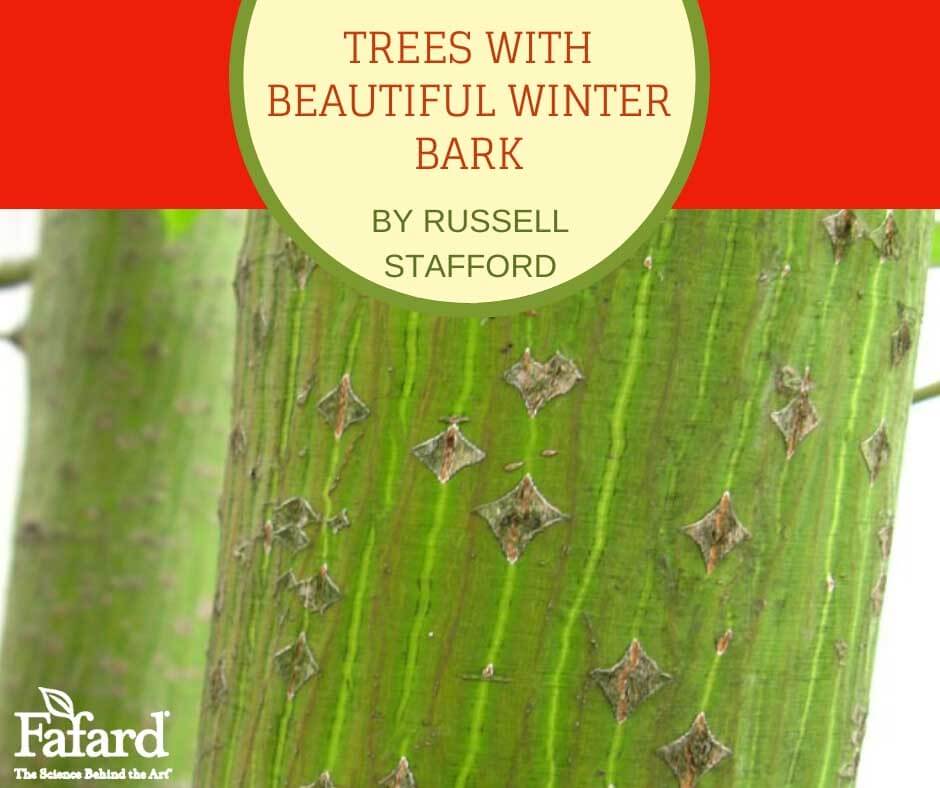
A number of hardy tree species possess bark that is eye-catchingly handsome, particularly in winter, when most everything else in the garden is dressed in frostbitten drab. Such trees are essential for bringing defining structure and color and texture to the winter landscape.
Maples

The maples have given us a number of trees that possess arresting bark, including the iconic paperbark maple (Acer griseum). In its best forms, this highly variable Chinese native slowly matures into a 25- to 35-foot, round-headed specimen with polished, flaking, cinnamon-brown bark that is especially striking when frosted with snow. The three-parted leaves assume sunset tones rather late in fall.
Paperbark maple interbreeds with another trifoliate East Asian maple (Acer nikoense), which has striking green streaked bark, to produce hybrids with finely shredded bark of a somewhat paler cinnamon-brown. A third species in the three-leaved maple tribe, three-flowered maple (Acer triflorum), has shaggily flaking, silvery- to creamy-gray bark. It, too, is a small to medium tree, perfectly sized for most residential gardens in USDA Cold Hardiness Zones 5b to 8. Sunny or lightly shaded sites work best.
Snake-bark maples constitute another group well worth growing for their colorful stems. Arguably the most beautiful is red-vein maple (Acer rufinerve). Some selections of this fast-growing, medium-sized tree have luminous lime-green bark marked with paler longitudinal fissures. Abundant, colorfully winged fruits dangle from the branches late summer and early fall. This Japanese native is closely related to our native moosewood (Acer pensylvanicum), which is sometimes represented in gardens by the red-stemmed cultivar ‘Erythrocladum’. Both do well in sun or partial shade.
Stewartias
Like the maples, the genus Stewartia is centered in temperate East Asia and eastern North America and contains several species with beautiful bark. The best known, Japanese stewartia (Stewartia pseudocamellia), bears white, camellia-like flowers in early summer, and oval leaves that go fiery in fall. Its most notable feature, however, is its multicolored bark, which exfoliates into mottled patches of gray and bronze and pinkish-tan. Other, far lesser known stewartias (including Stewartia rostrata and S. sinensis) are also beautifully mottled. Also noteworthy is Stewartia monadelpha, a relatively slight species whose bark resembles that of paperbark maple. All these stewartias are small, rather spreading trees that make good choices for sunny to partly shaded niches in modest-sized gardens. Most are hardy to USDA Zone 5b.
Lacebark Elm

A diverse species that occurs over a wide range of Asia in a wide variety of shapes and sizes, lacebark elm (Ulmus parvifolia) has given rise to numerous cultivars, including some dwarf selections that make ideal bonsai subjects. For the garden, forms with exfoliating bark are undoubtedly the most desirable, their trunks maturing into a stewartia-like patchwork. All forms flourish in full sun, and most will weather USDA Zone 5b conditions.
Persian Ironwood
Also notable for its showy patchwork bark (and also hardy into USDA Zone 5b) is a medium-sized tree from the witch-hazel family, Persian ironwood (Parrotia persica). Typically multi-stemmed and wide-spreading, it bears leaves that resemble common witch-hazel and produces curious little early spring flowers composed of clusters of purple stamens. Fall color is often a spectacular blaze of orange, red, and smoky purple, with the brightest coloration occurring in full sun.
Amur Chokecherry

One of the best ornamental trees for sunny niches in especially chilly regions (USDA zones 3 to 6), Amur chokecherry (Prunus maackii) grows rapidly into a medium-sized tree with lustrous, shredding, tawny-orange bark that fairly glows in the winter landscape. Rounded clusters of white flowers open in spring and are followed by small black fruits. Although relatively short-lived and prone to damage from heavy wet snow and ice, it is still unsurpassed as a four-season tree for cold-climate gardens.
Peking Tree Lilac
The Peking tree lilac (Syringa pekinensis) resembles Amur chokecherry both in its exceptional cold-hardiness (USDA zones 3 to 7) and in the exfoliating, coppery bark of its finest forms (such as ‘Copper Curls’). But this variable Manchurian native offers greater longevity and clay-soil tolerance, as well as a bevy of fleecy, fragrant early-summer flowers. Typically multi-stemmed, it grows at a moderate rate to 20 to 30 feet tall, prospering in most soils in full sun.
Amur Maackia
Copper-tinged bark and USDA Zone 3 hardiness are also among the virtues of another small tree from the harsh climes of Manchuria, Maackia amurensis. Amur maackia’s bark is remarkable not only for its rust-brown coloration but also for the diamond-shaped exfoliations that decorate its surface, inviting closer inspection. Upright candelabras of dull white flowers deck its branches in early summer. The pinnately compound foliage of this single-stemmed, round-crowned, leguminous tree is an attractive dark green in summer but offers little in the way of fall color. Growth is slow, even in ideal conditions (full sun and fertile, well-drained soil).
Plant one of these trees with beautiful winter bark next spring, and it will bring much-needed color and presence to the garden next winter (and for years to come). To get it off to a good start, give it a planting hole that’s about the same depth as the root ball, and three times as wide. Amend the backfilled soil with a bit of balanced fertilizer, as well as a humus-rich amendment such as Fafard Natural & Organic Compost Blend if the soil is excessively sandy or heavy.





